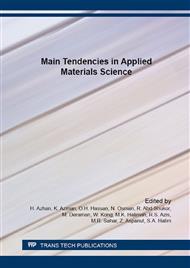p.3
p.13
p.20
p.27
p.37
p.45
p.52
p.58
An Evaluation of Microstructure and Hardness Properties of Zr Added FeNiAlCoCr High Entropy Alloys
Abstract:
High Entropy Alloy (HEA) with at least 5 elements with equimolar ratios were developed to investigate the characteristics of Zr added in FeNiAlCoCrZrx (x=0.0, 0.2, 0.4, 0.6, 0.8 and 1.0). HEAs were prepared by arc melting technique in Ar atmosphere and were remelted five times to ensure homogeneity. The microstructure and phase constitution of these alloys are examined by X-Ray diffraction (XRD) and Scanning Electron Microscope (SEM). The results show that addition of Zr to FeNiAlCoCr HEA resulted in multiple solid solution phases viz., BCC1, BCC2, FCC1 and FCC2 as evidenced by XRD patterns. Furthermore, presence of both BCC and FCC phases at higher Zr additions suggests that Zr did not preferentially promoted the solidification of either BCC or FCC phase. It can be observed from the FESEM micrographs that with different Zr additions, solidified microstructures of FeNiAlCoCrZrx alloys varied between completely eutectic microstructures to proeutectic and eutectic phase mixtures. From FESEM micrographs it can be suggested that different Zr contents have resulted in different solidification modes. Hardness of Zr added samples is higher compared to base HEA which is FeNiAlCoCr. It was observed that hardness values are higher when proeutectic phases were present compared to completely eutectic FeNiAlCoCrZr alloy (x=0.1).
Info:
Periodical:
Pages:
20-26
Citation:
Online since:
March 2016
Authors:
Keywords:
Price:
Сopyright:
© 2016 Trans Tech Publications Ltd. All Rights Reserved
Share:
Citation:


